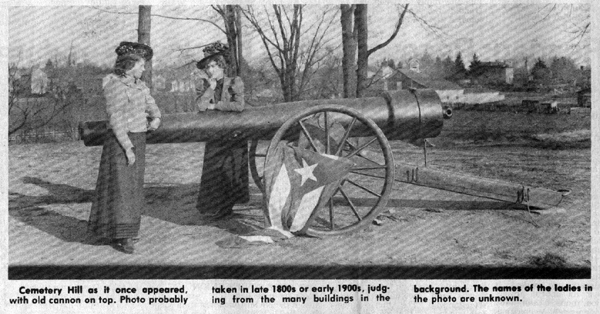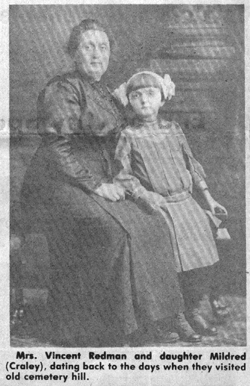July 29, 1982


Picture #1 – Cemetery Hill as it once appeared, with old cannon on top. Photo probably taken in late 1800’s or early 1900’s. Judging from the many buildings in the background. The names of the ladies in the photo are unknown.
Picture #2 – Mrs. Vincent Redman and daughter Mildred (Craley), dating back to the days when they visited old cemetery hill.
Many of the readers may have heard that the site of Fostoria City Hospital was once “Old Cemetery Hill” and some may even recall the original site before it was demolished to make way for the hospital.
Mrs. Chester (Mildred) Craley, former Fostorian, who has resided in Bloomdale since 1964, can do better than that. She recalls very vividly her visit to the old cemetery when she was a girl about eight.
I remember going to the old cemetery on top of the hill, accompanied by her mother. We lived at 903 Cory St., back then in about 1916. My parents were Mr. and Mrs. Vincent Redman. Sometimes my aunt Lula Hanna would go with us. I would always place flowers on one of the graves at each visit, she said in a conversation with me.
At the time of Mrs. Craley’s recollection of the cemetery, there weren’t many graves for her place flowers on. In fact there had never been too many burials at the site which dated back to 1832.
BODIES REMOVED SOME IDENTIFIED
In 1856, the bodies of Dr. Dana, Mr. Caples Sr., Louisa Howell, John Kelly, the Holopeters, Mrs. Braden and Mr. Jacobs were removed to the new cemetery, the present Fountain Cemetery.
The graves remaining in the old cemetery which could be identified by worn markers in 1886 were of Sarah N. Hatfield, died Aug. 6, 1839; William Hatfield, died 1844; John W. Welch, died Dec. 20, 1843; a daughter of J. and N. Conley, died Aug. 20, 1843; Samuel Carr, died Aug. 2, 1842; Catherine, wife of A.W. Childs, died about 1849; son of E.B. Howell, died Oct. 6, 1852; and William Hamor, died Dec. 21, 1851.
Other graves had lost their headstones or could no longer be identified.
It was on those remaining graves that Mrs. Craley, as a child placed a flower on each visit.
GORSUCH DONATED CEMETERY LAND
The old cemetery dates back to 1832, the same year the village of Rome was founded by C.W. Foster and Roswell Crocker. It was that same year that John Gorsuch founder of the village of Risdon, donated the site just west of Portage Creek to the Methodist church which was already established in the village to be used as a burial ground. A Mr. Jacobs was the first to be buried there in 1832.
Gorsuch’s provision was that should the land ever be abandoned as a burial ground, it should revert to him or his heirs.
It was used as a burial ground until 1856, when the new cemetery, west of it on the North Ridge Road (Van Buren Street), was established.
John Gorsuch died three miles north of Longley from a self inflicted gunshot. At the funeral, the Rev. Brock, pastor of the ME church, in paying tribute to the founder of Risdon and the donor of the cemetery ground, asked that Gorsuch’s remains be laid to eternal rest in the cemetery. However, the records do not indicate if his request was fulfilled, since no mention is recorded of removal of the remains to the new cemetery.
SITE SOUGHT FOR RESIDENCES
In later years, various persons were attracted by the beauty of the knoll and contemplated acquiring it as a residence site, and were prepared to have the bodies removed and buried elsewhere. But the inability to secure a title, owing to the will of Gorsuch and the unwillingness of his heirs, also the descendent of the Methodist Church to see the cemetery desecrated, prevented such steps being carried out. Then, in later years, Morris P. Skinner held a quit claim deed from the Gorsuch heirs for the property.
It remained for the city to find the legal means to acquire the old cemetery site to build Fostoria City Hospital there in 1930. At that time, the remains of those still buried there were removed to Fountain Cemetery.
Mr. Craley, like many of those years ago, thinks the cemetery should have been preserved.
I never visit the hospital, but I recall those visits to the old cemetery as a child. I remember the steps that led to the top of the hill and the fence that surrounded it.
CRALEY RECALLS OLD CANNONS
The accompanying photo, made from an old glass plate (used prior to invention of negatives as we know today), owned by Ray Dell, shows the old cannon that held a prominent spot on the cemetery hill. When the cannon was placed there or removed, I don’t know, In fact, I never remember seeing the cannon when I was a boy. However, when Mrs. Craley was shown the old photo, she instantly recalled the old cannon from her girlhood days.
The GAR (Grand Army of the Republic) always decorated the graves and held services at the cemetery on Memorial Day.
In later years, children often played on top of the hill and used it as a toboggan slide in winter.
OTHER OLD CEMETERIES
Many readers are not aware that other cemeteries were located in the area of what is now Fostoria, during its early days.
One was south of the site where the Fostoria Academy was built in 1879 on land donated by C.W. Foster. In later years, Foster Street in that area was named after C.W. Foster. It was somewhere in that vicinity that the cemetery was located, but the exact spot is not known.
Buried in it were: Emily Foster, John Foster and four of C.W. Foster’s children, and Mr. and Mrs. John Crocker and Allen Crocker. All of those were removed to what is now Fountain Cemetery in 1856.
Still another cemetery was located where the 7-11 Store is now at Countyline and Tiffin Streets. A Frederick Anderson whose body was buried there, was removed to Fountain Cemetery in 1856 also. There seem to be no other records of burial there.
The first Catholic cemetery was located where the parking lot just south of St. Wendelin Catholic Church is now. When the Atlantic and Lake Erie Railroad put in its road bed through that area in 1858, the bodies in that cemetery were moved to another cemetery established by the Catholic Church on Buckley Street. In 1889, the Catholic cemetery was established at its present site on Van Buren Street, and the bodies from the Buckley Street site were moved there.